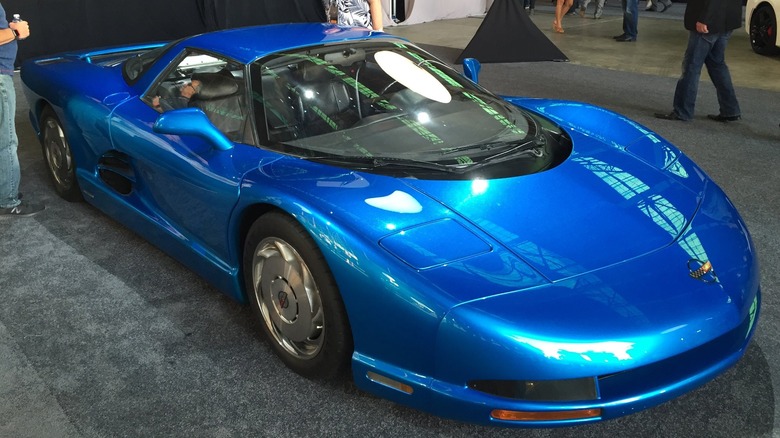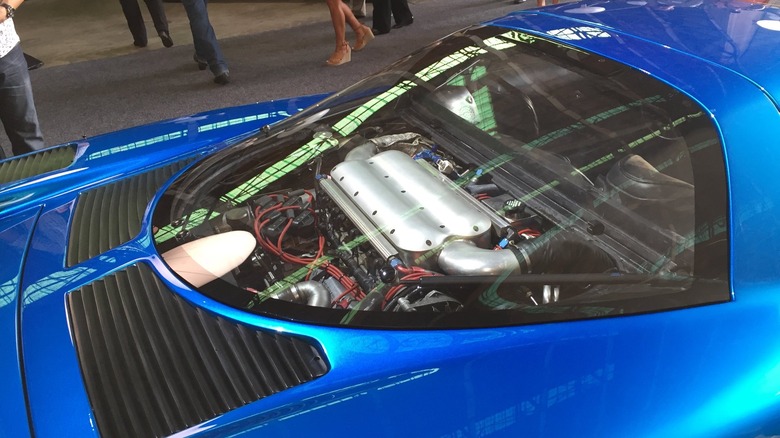The Forgotten Corvette Concept Car That We'd Take Over The C8 Every Time
Before announcing the Corvette C8 in July 2019, Chevrolet had dangled a score of muscled mid-engine carrots in front of car enthusiasts for nearly 60 years.
The Chevrolet Engineering Research Vehicles (CERVs) line started in 1960 with the CERV I; an open-topped, fuselage-shaped single seater that was wrapped around a 6.2-liter small-block V8 that went 206 mph (via Motor Trend). The CERV II, from 1964, was also an open-top car, but had two seats and was powered by a 550 horsepower V8 clocked at a 212 mph top speed. Over the next six years, there were six different versions of the CERV II created, with a cornucopia of setups, engine sizes, and options.
Both CERVs came from the mind of Corvette's first chief engineer — Zora Arkus-Duntov — but were never destined for production. They were strictly meant for racing (via Motor Trend). Then came the CERV III, which debuted at the 1990 Detroit Auto Show.
It looks nothing like the first two CERV versions, and instantly exudes street legal and production ready energy. It may also look familiar to those who know their Chevy concept cars, because it bears more than a passing resemblance to the Chevrolet Aerovette concept developed more than a decade earlier. It, too, was a mid-engine design from Arkus-Duntov.
Motor Trend says the CERV III evolved out of the 1986 Corvette Indy concept car. Still, one has to wonder with such eerily similar body stylings, if the Aerovette didn't play as much of a part in its development as the Indy concept.
Lotus inspiration ran throughout the CERV III
The third CERV was the "first functional, electronic high-tech Corvette concept car." Until the C8 prototypes were built, it remained the last Chevy mid-engine concept for decades (via Motor Trend).
The car was put together by Lotus (in England), so race car builders added more than a few touches to the overall feel of the CERV III, including a carbon fiber underbody and backbone chassis. The body was an exotic mix of carbon fiber, Kevlar, and Nomex, all reinforced by honeycombed aluminum (via Motor Trend).
To get inside, you lifted the Lotus-inspired scissor doors, but the interior was far from exotic. The dashboard did include an advanced (for its time) small CRT monitor that showed, among other things, a navigation system complete with road maps. An extended panel with over 20 command buttons sat to the right of the shifter along the center console with a gamepad-style four-way directional D-pad. Remember that GPS tech was still five years away (via Motor Trend).
The suspension was a mix of cutting-edge tech, and acted as the first iteration of the C7's unique version (via Motor Trend). The active suspension system (again inspired by Lotus) was monitored by a computer that kept track of pitch, yaw, and even tire slippage, then automatically adjusted the horizontal level of the car on the fly. The CERV III didn't use shock absorbers but went with actuators instead. Oh, and it had an anti-lock braking system (ABS), of course.
Third time was the charm for this CERV
Then we come to what sits under the hood, the mid-engine '90 CERV III. Sitting midship is a 32-valve DOHC version of the LT5 engine that wasn't set to debut in the Corvette's ZR-1 engine until later that same year. Another Lotus inspiration, the transverse-mounted 5.7-liter had not one, but two Garret T3 turbochargers strapped to the small-block V8 kicking out an astonishing 650 horsepower and 655 foot-pounds of torque. It went from 0-60 mph in 3.9 seconds, and had an estimated top speed of 225 mph, with a lateral acceleration of 1.1 g's (via Motor Trend).
Chevy installed a 6-speed automatic transmission that was about as wild as the car's rocket ship of a powerplant: two tweaked Turbo-Hydramatic 425 transmissions. It also had front and rear posi-differentials, all-wheel-drive, and four-wheel steering (via Motor Trend).
So why didn't this performance-enhanced, muscle-y super Corvette ever make it into production? Well, for starters, Chevy never meant for it to be mass-produced. Secondly, the ordinary person couldn't afford it. Estimates put an MSRP on a production version of the CERV III somewhere around the average price of today's home. Few and far between could afford a $300,000-$400,000 car in 1990. By comparison, the yet-to-be-released ZR-1 had an MSRP of $59,000, while a lowly standard model would only set you back some $32,000 (via Motor Trend). Hard to justify that kind of price difference to anyone.

